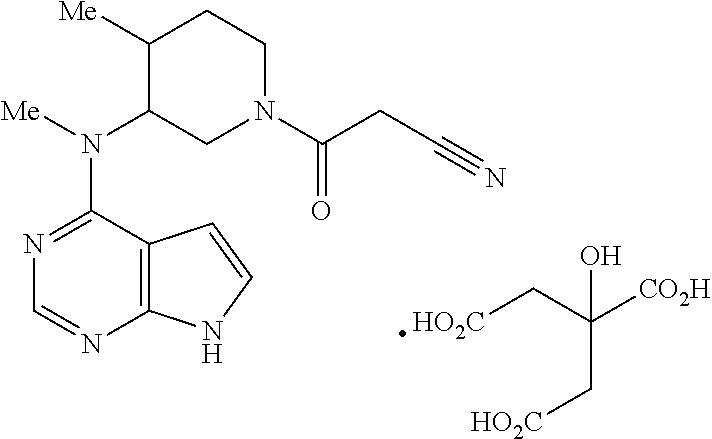Treatment of diabetes mellitus
a technology for diabetes mellitus and treatment, applied in the field of treatment of insulin-dependent diabetes mellitus, can solve the problems of increased risk of heart attack and stroke, neuropathy, retinopathy, death, etc., and achieve the effect of restoring metabolic homeostasis, and improving the effect of insulin resistan
- Summary
- Abstract
- Description
- Claims
- Application Information
AI Technical Summary
Benefits of technology
Problems solved by technology
Method used
Image
Examples
example 1
[0286]A 14 years old male patient diagnosed with IDDM was treated with 8 units of exogenous long-acting insulin per day (administered in the evening) and 1 unit of short-acting insulin per 6 grams of carbohydrate food intake (administered before each meal).
[0287]The patient was then treated twice-daily with a 5 mg dose of tofacitinib (calculated based on the weight of tofacitinib free base; corresponding to 8 mg of tofacitinib citrate) for a period of six months, using one tablet of the Xeljanz® immediate-release tofacitinib citrate tablet drug product twice-daily (BID). Starting three days post initiation of tofacitinib treatment, the patient did not receive any short-acting insulin and was kept solely on long-acting insulin (8 units per day, administered in the evening). Starting three weeks post initiation of tofacitinib treatment, the patient did not receive any exogenous insulin.
[0288]About six months post initiation of tofacitinib treatment, the tofacitinib dosing regimen was ...
example 2
[0296]A patient (appr. 60 kg) diagnosed with IDDM is treated with a combination of tofacitinib and IVIG at the following doses for a period of three months:
[0297](1) 16 mg tofacitinib citrate twice-daily (equivalent to 10 mg tofacitinib free base), using the Xeljanz® immediate-release tofacitinib citrate tablet drug product from Pfizer (each tablet including 8 mg of tofacitinib citrate, equivalent to 5 mg tofacitinib free base); and
[0298](2) a loading dose of 2 mg IVIG / Kg subject body weight on the first day of treatment followed by doses of 1 mg IVIG / Kg on the second and third day. This is followed by maintenance doses of 1 mg IVIG / Kg every three weeks. The Gamunex®-C immunoglobulin product from Grifols Therapeutics Inc. is used.
[0299]Three months after treatment initiation, the patient is treated for another three weeks with a combination tofacitinib / IVIG as before and additionally 375 mg / m2 rituximab once per week for three weeks.
[0300]Afterwards, rituximab is discontinued and th...
example 3
[0303]A patient is treated for IDDM with tofacitinib. The patient also receives IVIG for the treatment of IDDM. On the first three days of treatment with IVIG, 2, 1 and 1 mg IVIG / Kg subject body weight are administered, respectively. Then, the patient receives 1 mg IVIG / Kg subject body weight three weeks after the aforesaid dose on day three, and another 1 mg IVIG / Kg subject body weight dose three weeks later. One day after the last IVIG dose, the patient receives a dose of rituximab and then two more rituximab doses at one week intervals. Right after the third rituximab dose, the patient receives another 1 mg IVIG / Kg subject body weight dose, and then a last 1 mg IVIG / Kg subject body weight dose three weeks later. The patient continues to receive tofacitinib.
PUM
| Property | Measurement | Unit |
|---|---|---|
| concentration | aaaaa | aaaaa |
| concentration | aaaaa | aaaaa |
| weight | aaaaa | aaaaa |
Abstract
Description
Claims
Application Information
 Login to View More
Login to View More - R&D
- Intellectual Property
- Life Sciences
- Materials
- Tech Scout
- Unparalleled Data Quality
- Higher Quality Content
- 60% Fewer Hallucinations
Browse by: Latest US Patents, China's latest patents, Technical Efficacy Thesaurus, Application Domain, Technology Topic, Popular Technical Reports.
© 2025 PatSnap. All rights reserved.Legal|Privacy policy|Modern Slavery Act Transparency Statement|Sitemap|About US| Contact US: help@patsnap.com


